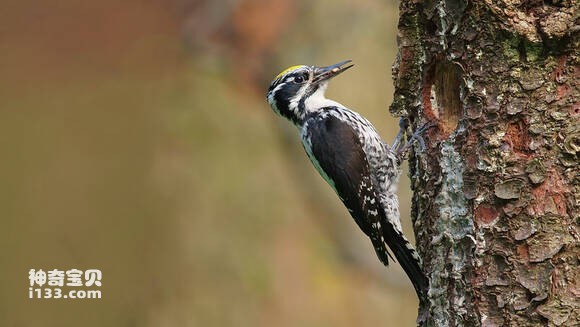Picoides tridactylus
IUCN
LCBasic Information
Scientific classification
- name:Picoides tridactylus
- Scientific Name:Picoides tridactylus,Eurasian three-toed woodpecker
- Outline:Climbing birds
- Family:Picipitidae Picidae Woodpecker
Vital signs
- length:20-23cm
- Weight:40-60g
- lifetime:About 11 years
Feature
There is a white vertical stripe behind the eye, the cheek stripe is white, the jaw stripe is black, the tarsometatarsus and toes are dark brown, and there are only 3 toes.
Distribution and Habitat
The three-toed woodpecker is distributed in Hulunbuir League in northeastern Inner Mongolia, Xiaoxing'anling in Heilongjiang, Changbai Mountain in Jilin Province, Kashgar in western Xinjiang, Tianshan and northwestern Xinjiang, northeastern and southern Qinghai, Gansu, northern, western and southwestern Sichuan, and northwestern Yunnan. Outside China, it is distributed in Eurasia, Japan, Alaska, Canada and the United States.
The three-toed woodpecker mainly inhabits coniferous forests and mixed coniferous and broad-leaved forests in mountainous and plain areas, especially in remote primitive coniferous forests.
Appearance
The male three-toed woodpecker's nose barbels are stained gray with black tips. The forehead is gray-white, and the feather bases are black; the top of the head is golden yellow, and the feather bases are also black; the eyes are black at first, mixed with gray-white feather tips; there is a white vertical stripe behind the eyes, extending backward to the side of the neck. The eyebrow lines and ear coverts are also black with a blue sheen. The cheek lines are white and the jaw lines are black, both extending to the side of the neck. The middle part is mixed with white feather tips, and the back neck is black with blue luster and mixed with white fine lines. The back and waist are white with black stripes. The upper tail coverts and the two central pairs of tail feathers are black, and the remaining tail feathers are black with broad white horizontal spots and end spots. The feathers on the shoulders and wings are dark brown, and the flight feathers are also dark brown, mixed with
Details
The three-toed woodpecker is called Eurasian Three-toed Woodpecker in English. It is a small bird with 8 subspecies.

The three-toed woodpecker is a typical forest bird. Except for the breeding season, it often acts alone. In the late breeding period, it also forms a family group. It is active in the middle and upper parts of the forest, and sometimes it also moves and forages on the ground. It is lively, agile, and pecks quickly and forcefully. It feeds mostly on dead branches. It rarely sings at ordinary times. Its call during the breeding season is similar to the monosyllabic "ga-ga-ga" of the spotted woodpecker, but it is lower and hoarse than that of the spotted woodpecker. It mainly feeds on various insects such as longhorn beetle adults and larvae, click beetles, coleoptera adults and lepidoptera larvae, and formicidae adults. Sometimes it also eats plant seeds, especially pine nuts, especially in the winter when food is scarce.

The breeding season of the three-toed woodpecker is from May to July. They start to form pairs and show courtship behavior in April, and start to build nests in early May. They build nests in tree holes, which are pecked by male and female parents. They usually choose broad-leaved trees with rotten heartwood or dead standing trees. They do not use old nests, and they peck the nest holes again every year. Each nest hole takes about 15 days to peck. The hole is round with a diameter of 4-5 cm, an inner diameter of 6-14 cm, a depth of 20-30 cm, and a height of 2-8 meters from the ground. Each nest lays 3.6 eggs, usually 4-5 eggs. The eggs are white and 21-28 mm × 16-19 mm in size. The male and female take turns incubating the eggs, and the incubation period is 14 days. The chicks mature late.

The three-toed woodpecker has a wide distribution range and is not close to the critical value of vulnerable and endangered species survival (distribution area or fluctuation range is less than 20,000 square kilometers, habitat quality, population size, and distribution area fragmentation), so it is evaluated as a species of least concern.

Listed in the "Red List of Threatened Species of the World Conservation Union" (IUCN) 2016 ver 3.1-Least Concern (LC).
Listed in the second level of China's "National Key Protected Wildlife List" (February 5, 2021).
Protect wild animals and stop eating game.
Maintaining ecological balance is everyone's responsibility!








